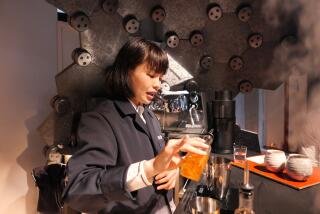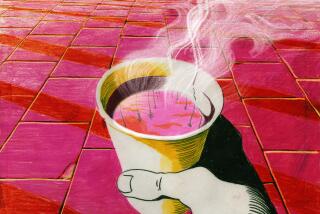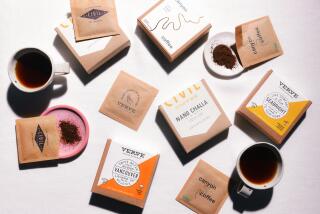Espresso Machines Pouplar Gifts
- Share via
Almost all of the espresso machines on the market can be divided into two categories: steam systems and pump systems. Because these appliances are so often bought as Christmas gifts, they are timely candidates for this column.
Six steam units and eight pump units were borrowed from their manufacturers for evaluation. The 14 machines included models manufactured in Italy, Switzerland, Taiwan and Hong Kong.
Prices of the units range from $66 to $500. (Dollar amounts listed are suggested retail prices; units can often be purchased at reduced prices.) Although machines within each of the two categories operate similarly, there are subtle differences and it’s important to read and follow the manufacturer’s instructions.
Steam units currently account for about 70% of espresso machine sales in this country. They are the least expensive, ranging from $66 to $200.
In steam machines, water heats in a chamber until enough pressure has built up to force it through the ground coffee. In most steam machines, the entire amount of water in the chamber flows through at once.
These units produce coffee that is denser than that made in a drip or filter coffee maker, but do not produce the crema, or tan-colored foam, that is a sign of high-quality espresso (Please see Tips for Using an Espresso Machine on Page 47 for a full explanation). Steam produced by these machines typically increases the volume of 1/4 cup of milk to 1/3 or 1/2 cup.
Five of the six steam machines tested offered the option of producing either two or four cups of espresso, plus steam for frothing milk to make cappuccino. The sixth unit, Neon Cafe Amore, had the capability of producing from one to six cups of espresso plus steam.
Only one of the machines provided much space for overflow. This is not a problem when the coffee flows into a carafe, but it can be when a two-cup adapter is used and the unit produces more than two cups of liquid. It was also a problem when the coffee valve on one Neon Cafe Amore machine malfunctioned.
Pump machines are more expensive than steam machines ($235 to $500). In these units water is stored in a reservoir then heated and sent under pressure through the coffee grounds. Pump machines offer the option of making one or two cups of espresso at a time. The steam generated by these machines typically increases the volume of a 1/4 cup of milk from 1/2 to a full cup.
All of the units tested had good overflow space and removable drip trays. This is important since the machines tend to drip water and coffee.
For optimum flavor, the temperature of the water should be just below boiling when it comes in contact with the coffee grounds.
CONCLUSIONS:
It takes time and experimentation to produce the best espresso/cappuccino from any machine. Follow the manufacturer’s instructions plus the guidelines on Page 47 for selecting and grinding coffee.
If you truly care about good espresso, you won’t be satisfied with a steam machine, even though they are less expensive, easy to use and typically have fewer mechanical problems. They cannot produce a high-quality espresso with crema, so are best used for making cappuccino.
Pump machines produce better to excellent quality espresso with crema. These are higher in price, more complicated and messier to use and subject to more mechanical problems.
EVALUATION:
With the exception of units that had mechanical problems, all machines were tested several times, following the manufacturer’s directions as closely as possible.
STEAM SYSTEM MACHINES
BRAUN ESPRESSO MASTER (7)--Makes two or four cups espresso. To prepare cappuccino, half the espresso is brewed, the milk is steamed by moving a lever to the steam-only setting, then returned so the remaining espresso is brewed. Three cups of water yielded 2 1/2 cups espresso and steam for frothing. Milk steamed increased from 1/4 to 1/3 cup. Water temperature was 185 degrees; coffee, 180 degrees. Coffee appeared murky. Grounds were fairly dry.
Ample overflow capacity. Frother is stationary and has limited clearance; “Turbo Cappuccino” attachment detaches for easy cleaning.
NEON CAFE AMORE (5)--Only steam machine evaluated that offers controlled brewing from one to six cups of espresso/cappuccino. Milk is steamed after brewing espresso.
Milk steamed increased from 1/4 to 1/2 cup. Water temperature was 190 degrees; coffee, 190 degrees. Coffee appeared murky. Grounds were fairly dry.
Limited overflow capacity. Frother oscillates and has limited depth clearance. No brew basket guard. No cord storage.
GAGGIA FANTASTICO II (3)--Makes two or four cups espresso. For cappuccino, milk is steamed during brewing. Three cups of water yielded 2 1/2 cups espresso plus steam for frothing.
Milk steamed increased from 1/4 to a scant 1/3 cup. Water temperature was 180 degrees; coffee, 165 degrees. Coffee appeared murky. Grounds were fairly dry.
Fifteen-inch cord for safety. Limited overflow capacity. Frother is stationary and has limited depth clearance.
KRUPS IL PRIMO (8)--Makes two or four cups espresso. For cappuccino, espresso is brewed to steaming mark on carafe; milk is steamed, then remainder of espresso is brewed. Three cups water yielded 2 1/2 cups espresso plus steam for frothing.
Milk steamed increased from 1/4 to 3/4 cup. Water temperature was 175 degrees; coffee, 180 degrees. Coffee appeared murky. Grounds were fairly dry.
Limited overflow capacity. Frother is stationary and has limited depth clearance.
MAXIM EXPRES (6)--Makes two or four cups espresso. For cappuccino, milk is steamed during brewing. Three cups water yielded two cups espresso plus steam for frothing. For safety, manufacturer advises opening steam value to release any residual pressure before removing brew basket.
Milk steamed increased from 1/4 to 1/3 cup. Water temperature was 180 degrees; coffee, 160 degrees. Coffee appeared murky. Grounds were fairly dry.
Limited overflow capacity. Frother is stationary and has limited clearance.
SALTON ESPRESSO/CAPPUCCINO MAKER (4)--Makes two or four cups espresso. For cappuccino, milk is steamed during brewing. Three cups of water yielded two cups espresso plus steam for frothing. For safety, manufacturer advises opening steam value to release any residual pressure before removing brew basket.
Milk steamed increased from 1/4 to 1/2 cup. Water temperature was 183 degrees; coffee, 185 degrees. Coffee appeared murky. Grounds were fairly dry.
Frother is stationary and has limited clearance. No brew basket guard.
PUMP SYSTEM MACHINES
CUISINART ESPRESSO/CAPPUCCINO (13)--For safety, manufacturer advises waiting at least one minute for pressure to dissipate before removing brewing basket.
Water reservoir awkward to get into place after filling. Water temperature was 180 degrees. Frother oscillates. Drip tray is easy to clean.
DeLONGHI BAR ESPRESSO (12)--For safety, manufacturer advises waiting 30 seconds for pressure to dissipate before removing brewing basket.
Reservoir easy to fill. Ground coffee or coffee pods may be used. Coffee switch must be held down while brewing.
Milk steamed increased from 1/4 to 3/4 cup. Water temperature was 170 degrees; coffee, 170 degrees. Produced good crema. Grounds were fairly dry.
Frother oscillates. Brew-basket guard folds down into handle for convenience. Drip tray was easy to clean.
GAGGIA ESPRESSO (9)--For safety, manufacturer advises carefully and slowly removing brew basket to release pressure.
Reservoir easy to fill from top. Coffee and steam switches are small.
Milk steamed increased from 1/4 to one cup. Water temperature was 170 degrees; coffee, 165 degrees. Produced good crema. Grounds were dry.
Frother is stationary and has limited clearance. Drip tray was easy to clean.
KRUPS L’ESPRESSO PLUS (14)--Reservoir easy to fill. Designed to be used with espresso pods, but may be used with lightly tamped grounds.
Milk steamed increased from 1/4 to 1/2 cup. Water temperature was 170 degrees; coffee, 160 degrees.
Frother oscillates. Brew basket for grounds has guard. Drip tray is easy to clean.
ROTEL ESPRESSOMAT (11)--Reservoir easy to fill. Convenient storage in lid.
Milk steamed increased from 1/4 to one cup. Water temperature was 180 degrees; coffee, 180 degrees. Produced good crema.
Water temperature regulator showed 20 degree variation. Frother oscillates.
SPIDEM CAPPUCCINO EXPRESS (10)--Steel exterior housing. Handle of brew basket is swung to left to release coffee, back to right to produce steam for frothing.
Milk steamed increased from 1/4 to 1/2 cup. Water temperature was 160 degrees; coffee, 140 degrees. Produced good crema.
Frother oscillates and has good clearance. Drip tray is easy to clean.
BABY GAGGIA (2)--For safety, manufacturer advises carefully and slowly removing brew basket to release pressure.
Reservoir easy to fill from top. Dark color obscures water level.
Milk steamed from 1/4 to one cup. Water temperature was 170 degrees; coffee, 165 degrees.
Frother is stationary and has limited clearance. Drip tray is easy to clean.
RANCILIO RIALTO (1)--Reservoir easy to fill. Frother is stationary, but has good clearance. Drip tray is easy to clean.
Milk steamed increased from 1/4 to one cup. Water temperature was 180 degrees; coffee, 175 degrees. Produced good crema.
RESOURCES:
BRAUN--Manufactured in Italy. Currently available in black; however model will be offered in white beginning January 1991.
Company plans to introduce a pump machine in spring 1991.
Available at: Broadway department stores, May Company and Bullock’s department stores.
CAFE AMORE--Manufactured in Taiwan. Also available with red neon/black body and green neon/black body.
Company also markets a model without neon for about $100.
Available at: Cook ‘N’ Things, South Pasadena, and the Coffee Collection, Orange County.
CUISINART--Manufactured in Italy. Also available in black.
Available at: Robinson’s department stores and Coast Hardware, Laguna Beach.
DeLONGHI--Manufactured in Italy.
Company also markets the Caffe Espresso model, a pump system machine for $169, which was not evaluated.
Available at: Adray’s in Los Angeles, Van Nuys and Torrance.
GAGGIA--Manufactured in Italy.
Fantastico II and Baby Gaggia also available in white. Espresso available only in white.
Company also makes other models.
Gaggia Fantastico II available at: Gloria Jeans, Thousand Oaks; Cook’s Corner, San Diego; Claremont Tea and Coffee, Claremont; Cook’s Works, West Los Angeles; Kitchen Collection, Huntington Beach.
Gaggia Espresso available at: Cafe Noir, Rolling Hills; Gloria Jeans, Thousand Oaks; Coffee and Things, Canoga Park; Cook’s Corner, San Diego; Claremont Tea and Coffee, Claremont; Kitchen Collection, Huntington Beach.
Gaggia Baby available at: Coffee Junction, Tarzana; Crown Hardware, Costa Mesa; Coffee and Things, Canoga Park; Coffee Roaster, Sherman Oaks.
KRUPS--Manufacturered in Switzerland.
Il Primo is also available in white.
L’Espresso Plus available in black. Comes with five boxes (100 servings) of espresso pods.
Company also markets several other models.
Available at: Bullock’s department stores, Robinson’s department stores, May Co . and Broadway department stores.
MAXIM--Manufactured in Hong Kong. Also available in white.
Company also markets other models.
Available at: Bullock’s department stores, May Co . and Robinson’s department stores.
RANCILIO--Manufactured in Italy. Also available in white/red.
Company also markets other models.
Will be available in January at: The Brewery, Santa Monica; Kitchen Things stores in Orange County.
A similar machine with additional features is offered for $500 at Graffeo, Beverly Hills.
ROTEL--Manufactured in Switzerland. White only.
Company also makes other models.
Available at: Jurgensen’s Grocery Co . stores; Kitchen World, Santa Monica Place; A Store for Cooks, Laguna Niguel.
SALTON--Manufactured in Switzerland. Also available in white.
Company also markets several other models.
Available at: Bullock’s department stores, May Co . and Robinson’s department stores.
SPIDEM CAPPUCCINO EXPRESS--Manufactured in Italy. Also available in white.
Not available in Southern California, but may be ordered from Pacific Espresso, 623 Soquel Ave., Santa Cruz, Calif. 95062, (408) 429-1920.
PRODUCT COMPARISON
Make & Model: Braun (7) Espresso Master, Model E200T (black)
Price: $119 to $129.
Features: Steam system; “Turbo Cappuccino” attachment; glass carafe; brew basket guard; two-up adapter; steam-only setting; removable drip tray; cord storage underneath.
Comments: Best feature: Easy to use.
Biggest drawback: company representative had trouble operating frother on first machine -- may have been assembled incorrectly. Second unit performed without problems.
Make & Model: Cafe Amore (5) Neon, Model 30210
Price: $200. (blue neon/black body)
Features: Steam system; one to six cup capacity with turn off value; independent coffee and steam valves; flashing neon indicates readiness.
Comments: Best feature: Coffee valve permits making one to six cups at a time.
Biggest drawback: First machine tested had faulty coffee valve, however manufacturer provided second unit which performed without problems.
Make & Model: Gaggia (3) Fantastico II, Model 42029 (black)
Price: $100.
Features: Steam system; “Turbo Frother” steam jet; glass carafe; two-cup adapter.
Comments: Best feature: Easy to use.
Biggest drawback: Very short cord (designed for safety) necessitates unit be placed every near outlet or use of extension cord.
Make & Model: Krups (8) II Primo, Model 972-42 (black)
Price: $99.
Features: Steam system; “Perfect Froth” attachment; glass carafe; two-cup adapter; brew basket guard; cord storage underneath.
Comments: Best feature: Frothing attachment produced greatest volume of steam units tested.
Biggest Drawback: Frother has limited depth clearance.
Make & Model: Maxim (6) Expres, Model EX-152 (black)
Price: $60.
Features: Steam system; filter basket guard; cord storage underneath; package includes cups and an instruction video tape.
Comments: Best feature: Produced optimum amount of espresso plus steam for frothing.
Biggest drawback: Filter basket guard is very flimsy.
Make & Model: Salton (4) Espresso/Cappuccino Maker, Model EX-8BLK (black)
Price: $70.
Features: Steam system; two-cup adapter; cord storage underneath.
Comments: Best feature: Produced optimum amount of espresso plus steam for frothing.
Biggest drawback: Nothing significant.
Make & Model: Cuisinart (13) Espresso/Cappuccino, Model EPM7 (white) and EPM7B (black)
Features: Pump system; water softening filter; super-cream disc; see-through reservoir; suction-cup feet; cord storage in black; built in tamper.
Comments: Best feature: Built in tamper.
Biggest drawback: Brew basket refused to engage after initial test so further evaluation was impossible.
Make & Model: DeLonghi (12) Bar Espresso/Cappuccino, Model BAR
Price: $219.
Features: Pump-driven boiler system; self-priming; 0.4 gallon reservoir with lifting handle; filter on water intake tube; water level indicator; removable drainage tray; brew basket guard; variable steam nozzle; dual thermostats; ready lights for power, coffee and hot water/steam; suction-cup feet.
Comments: Best feature: Produced good crema.
Biggest drawback: Steam knob jammed after second usage, was repaired following manufacturer’s instructions, but jammed again.
Make & Model: Gaggia (9) Espresso, Model 42034 (white)
Price: $250.
Features: Pump-drive system; “Turbo Frother” steamjet; cleaning needle; 30-cup, see-through reservoir; dual thermostats; removable drip tray; cup warming area.
Comments: Best feature: Machine was judged highest for performance and price of the three Gaggia models evaluated.
Biggest drawback: Small coffee and steam switches.
Make & Model: Krups (14) L’Espresso Plus, Model 969-42
Price $375.
Features: Thermo-block heating system; 28-ounce, removable water reservoir; ready light for water thermostat; “Perfect-Froth” attachment; brew basket guard.
Comments: Best feature: Convenience and neatness of using espresso pods.
Biggest drawback: Gasket in brew head must be kept clean when using ground coffee for it to seal correctly.
Make & Model: Rotel (11) Espressomat, Model S24.0
Price: $300.
Features: Pump-driven thermal block; status lights; 54-ounce, see-through water reservoir; 15-second reheat cycle between servings; water temperature regulator.
Comments: Best feature: Judged highest on performance for the price.
Biggest drawback: Drip tray inconvenient to clean.
Make & Model: Spidem (10) Cappuccino Express (black)
Price: $325.
Features: Pump-driven boiler system; 1.3 liter water reservoir; water level indicator; indicator lights; pressurized brewing basket.
Comments: Best feature: Produced good crema.
Biggest drawback: Must be ordered by mail.
Make & Model: Gaggia (2) Baby, Model 42522 (black)
Price: $500.
Features: Dual pump-drive system; dual thermostats; “Turbo Frother” steamjet; cleaning needle; 30 cup reservoir.
Comments: Best feature: Push button operation.
Biggest drawback: Lack of durability of exterior housing.
Make & Model: Rancillo (1) Rialto, Model 100BW (white/black)
Price: $400.
Features: Pump-driven boiler; status lights; adjustable steam control; 45-ounce reservoir; metal housing finished in porcelain enamel.
Comments: Best feature: Very solidly built.
Biggest drawback: Higher cost.
More to Read
Eat your way across L.A.
Get our weekly Tasting Notes newsletter for reviews, news and more.
You may occasionally receive promotional content from the Los Angeles Times.










